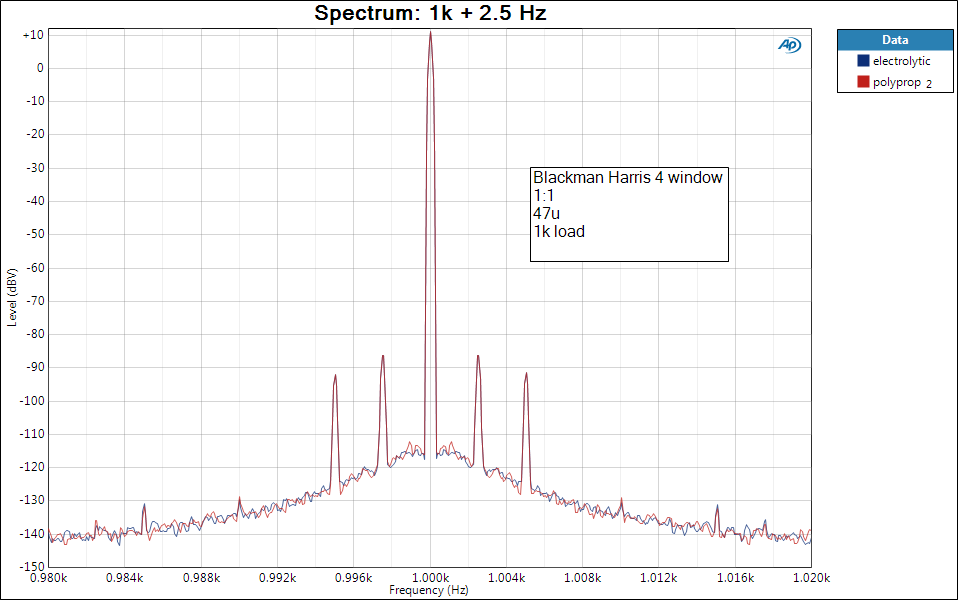I swear, I’ll stop soon.
Just for fun, I set up the 1k resistor/47-50u capacitor combo again, same components as before (polypropylene vs. back-to-back electrolytics), but for a test signal, used a combination of 1kHz and 2.5 Hz sine waves, still set for 8VRMS. The distortion spectrum looked pretty much the same as before, but I thought it would be interesting to see what the sidebands looked like. I zoomed in on the 1kHz peak, changed the window to Blackman-Harris 4 (better resolution of sidebands), and changed the sampling rate to 48k to decrease bin width (again, helping resolution). The comparative data are shown here.
Well, well, whaddaya know.
I swear I’ll stop soon.


LOL,
Luv you dude.
Well still no damn evidence of difference. Those traces minus the noise
seem pretty much the same. BUT! IT IS NOT MUSIC,…
Playing the Devil Advocate,…. And just having fun with you.
But um,… being dumb here – what is with the 1000 +/- 5Hz side bands?
We used music in the listening tests, where no-one showed detection by ear of any significant differences. But of course, it’s easy to measure differences that can’t be heard, and that’s what I’m looking for here.
If you’re curious, you can use DiffMaker to see how far down any differences with your choice of music might be.
Thanks for the Diffmaker note.
Should be an interesting tool.
Hi,
capacitors may in certain applications distort a signal and even emmit “sound”.
It all depends on the caps construction, polarisation, frequency, and most of all the level of current trough them.
None the less, bypassing electrolyts with high quality film caps may make more troubles than it would solve because of the resonant peak it migth create.
Peter, I remember an AES study, many years ago, that looked at the mechanical issues in film caps. They had some fancy laser interferometer equipment or some such to measure vibrations of a quality film coupling cap due to magnetostriction and electrostriction. They could prove that indeed, as some frequencies and levels the cap body did start to vibrate but the excursions measured were at the molecule size level. Not something I would expect to muck up my listening.
OTOH, some boutique crossover caps apparently are loosely wound and exposed to high currents and they could be singing.
The only (little) problem I have with electrolytic capacitors is aging – but I think exchanging them every 20 years should be sufficient to maintain reliability 😀
Thanks for sharing, very interesting, although everything looks as expected.
Now I wonder if moving below 100Hz and above 15KHz will show any changes.
In terms of distortion they look equal, but there are more aspects on “sound of components”: What about microphone ?
Do you mean microphonics? Yes, as I mentioned, loosely wound caps or those with mechanically poor dielectrics can be susceptible to microphonics. I have never experienced it with machine-wound mass production film caps from mainstream suppliers like Vishay, Panasonic, Wima… Likewise, even the cheap electrolytics I used here showed no significant microphonic effects. It’s easy to test- put it in a circuit, tap lightly, and listen to the circuit’s output.
Did you also measure and compared elyt vs film as bypass when also blocking DC i.e. the incoming signal has a substantial DC level potential – say 0,1V AC and at the same time, 2V DC`?
I’ve enjoyed reading the commendable articles on here about capacitors.
And as a long-time (now semi-retired) professional service technician in the audio-video world, I must say that the obsessions about capacitors and how they allegedly sound are amusing.
Numerous audio blogs across the internet all seem to promote endless and annoying capacitor propoganda.
The Recapping craze, endless suggestions of brand names, types…. I, as a highly experienced tech have to turn off those blogs.
It can drive a person nuts!
And I’ve been bombarded, even blocked, from numerous web blogs because I’ve opened my mouth to pass on some sane advice.
It’s fine, no skin off my hide.